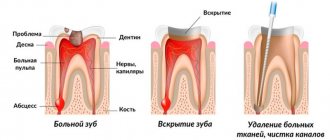Root, its properties, root extraction This article continues the topic of the root of a number. Here we will deal with root extraction . First, let's define what is called root extraction and establish when the root is extracted. Next, we will study the principles on which finding the value of a root is based, after which we will use examples to consider the main methods of extracting roots from natural numbers, and then from fractional numbers.
Page navigation.
- What does root extraction mean?
- When is the root extracted?
- Methods and examples of root extraction. Using a table of squares, a table of cubes, etc.
- Factoring a radical number into prime factors.
- Extracting roots from fractional numbers.
- Extracting the root of a negative number.
- Bitwise determination of the root value.
What is square root
The definition of the arithmetic square root does not add clarity, but it is worth learning it:
| The arithmetic square root of a non-negative number a is a non-negative number whose square is equal to a . |
The definition of a square root can also be represented in the form of formulas: √a = x x2 = ax ≥ 0 a ≥ 0
From the definition it follows that a cannot be a negative number. That is, what is under the root is necessarily a positive number.
To understand why it is this way and no other way, let's look at an example.
Let's try to find the root of √-16
Here it is logical to assume that 4, but let's check: 4 * 4 = 16 - does not converge.
If - 4, then -4 * -4 = 16, (minus by minus always gives a plus).
It turns out that not a single number can give a negative result when squared.
The numbers under the root sign must be positive.
Based on the definition, the value of the root must also not be negative .
Here reasonable questions may arise as to why, for example, in the example x2 = 16, x = 4 and x = -4.
Finding square roots using a table of squares
One of the simplest ways to calculate roots is to use a special table . What is it and how to use it correctly?
Using the table, you can find the square of any number from 10 to 99. The rows of the table contain the values of tens, and the columns contain the values of units. The cell at the intersection of a row and a column contains the square of a two-digit number. In order to calculate the square of 63, you need to find a row with a value of 6 and a column with a value of 3. At the intersection we will find a cell with the number 3969.
Since extracting the root is the inverse operation of squaring, to perform this action you must do the opposite: first find the cell with the number whose radical you want to calculate, then use the values of the column and row to determine the answer. As an example, consider calculating the square root of 169.
We find a cell with this number in the table, horizontally we define tens - 1, vertically we find units - 3. Answer: √169 = 13.
Similarly, you can calculate cube and nth roots using the appropriate tables.
The advantage of the method is its simplicity and the absence of additional calculations. The disadvantages are obvious: the method can only be used for a limited range of numbers (the number for which the root is found must be in the range from 100 to 9801). In addition, it will not work if the given number is not in the table.
Difference between square root and arithmetic quadratic equation
First of all, to differentiate between these two concepts, remember:
- x2 = 16 is not equal to x = √16.
These are two expressions that are not identical to each other.
- x2 = 16 is a quadratic equation.
- x = √ 16 is the arithmetic square root.
From the expression x2 = 16 it follows that:
- |x| = √16, this means that x = ±√16 = ±4, x1 = 4, x2 = -4.
If the two vertical sticks next to x confuse you, read our article on the modulus of a number.
At the same time, from the expression x = √16 it follows that x = 4.
If the situation still seems confusing and illogical, just remember that a negative number can only be a solution in a quadratic equation. If the solution is “minus”, there are two options:
- Example solved incorrectly
- This is a quadratic equation.
If you take the square root of a number, you can be sure that you will get a “positive” result.
Let's look at an example to finally clarify the difference between a square root and a quadratic equation.
Two expressions are given:
- x2 = 36
- x = √36
The first expression is a quadratic equation.
|x| = √36 x1 = +6 x2 = -6.
The second expression is the arithmetic square root.
√36 = 6 x = 6.
We see that the result of solving the first expression was two numbers - negative and positive. And in the second case - only positive.
Writing irrational numbers using square roots
An irrational number is a number that cannot be expressed as a fraction.
Most often, irrational numbers can be found in the form of roots, logarithms, powers, etc.
Examples of irrational numbers:
√2 = 1,414213…;
π = 3.141592…;
e = 2.718281…. .
To simplify the writing of irrational numbers, mathematicians introduced the concept of square roots. Let's look at a couple of examples to see the square root in action.
The equation is given: x2 = 2.
We immediately run into a problem, since obviously no integer is suitable.
Let's look at the numbers to make sure:
1 * 1 = 1, 2 * 2 = 4, 3 * 3 = 9.
Negative numbers give the same result. This means that the result of the solution cannot be integers.
The solution is as follows: Build a graph of the function y = x2 . We mark the solutions on the graph: -√2; √2.
If you try to extract the square root of 2 using a calculator, the result will be as follows: √2 = 1.414213….
The answer is not written down in this form - you need to leave the square root. x2 = 2. x = √2 x = -√2.
Final calculations
So, we have 2 candidate numbers left. How do you know which one is the root? The answer is obvious: square both numbers. The one that squared gives the original number will be the root.
For example, for the number 3364 we found two candidate numbers: 52 and 58. Let's square them:
522 = (50 +2)2 = 2500 + 2 · 50 · 2 + 4 = 2704; 582 = (60 − 2)2 = 3600 − 2 · 60 · 2 + 4 = 3364.
That's all! It turned out that the root is 58! At the same time, to simplify the calculations, I used the formula for the squares of the sum and difference. Thanks to this, I didn’t even have to multiply the numbers into a column! This is another level of optimization of calculations, but, of course, it is completely optional 
Root extraction
Solving examples with square roots is much easier if you memorize as many squares of numbers as possible. To do this, use the table -
and use it to solve puzzles.
Table of squares
Here are some examples of root extraction to help you learn how to use the table:
- 1. Take the square root: √289
We look for the number 289 in the table, move from it to the left and up to determine the numbers that form the number we need.
Left - 1, up - 7.
Answer: √289 = 17.
- 2. Take the square root: √3025
We look for the number 3025 in the table. Left - 5, up - 5.
Answer: √3025 = 55.
- 3. Take the square root: √7396
We look for the number 7396 in the table.
Left - 8, up - 6.
Answer: √7396 = 86.
- 4. Extract the root: √9025
We look for the number 9025 in the table.
Left - 9, up - 5.
Answer: √9025 = 95.
- 5. Extract the root √1600
We are looking for the number 1600 in the table.
Left - 4, up - 0.
Answer: √1600 = 40.
Extracting a root is finding its value.
Root limitation
First of all, we need to find out between which numbers our root is located. It is highly desirable that the numbers be multiples of ten:
102 = 100; 202 = 400; 302 = 900; 402 = 1600; … 902 = 8100; 1002 = 10 000.
We get a series of numbers:
100; 400; 900; 1600; 2500; 3600; 4900; 6400; 8100; 10 000.
What do these numbers tell us? It's simple: we get boundaries. Take, for example, the number 1296. It lies between 900 and 1600. Therefore, its root cannot be less than 30 and greater than 40:
[Caption for the picture]
The same thing applies to any other number from which you can find the square root. For example, 3364:
[Caption for the picture]
Thus, instead of an incomprehensible number, we get a very specific range in which the original root lies. To further narrow the search area, move on to the second step.
Removing the multiplier from under the root sign
It seems that we have figured out how to add a multiplier to the root. But algebra is such an algebra, so now it would be nice to remove the factor from under the root sign.
An expression is given in the form of the square root of the product.
You can probably easily find the square root of anything by now, so you know what to do.
We extract the root of all available factors.
In this expression, we can only take the square root of 4, so:
Thus, the multiplier is taken out from under the root sign.
Let's look at examples. Try to remove the factors from under the root sign yourself, checking the answers.
- √28
We factor the radical expression 28 = 7*4.We take the root of 4. We leave the factor 7 under the root sign.
- Answer: according to the rule for extracting the square root of a product, Since the factor taken out must be in front of the radical sign, we swap them.
- Remove the factor from under the root sign in the expression: √24
Answer: We factor the expression under the root into factors 24 = 6 * 4. - Simplify the expression:
Let us take out the factor from under the root sign in the last two expressions.
Multiply (-4 * 4) = -16. We write the rest of the expression unchanged.
We see that in the entire expression there is one common factor - √5. Let's take the common factor out of brackets:
Next, we calculate everything in brackets:
Why is it possible to replace the root with a product?
In this section we will understand how such a replacement is possible and why the root B n · C n is equivalent to the products of B · C n and B · C n . Let us turn to previously studied theoretical provisions.
When we looked at the transformation of irrational expressions, we got some important results that we collected in a table. Here we will need only two of them:
1. The expression A · B n, if n is odd, can be replaced by A n · B n, and for even n – A n · B n.
2. The expression A nn can be converted to A if n is odd, and to | A | .
Using these results and knowing the basic properties of the module, we can deduce the following:
- for even n: B n · C n = B nn · C n = B · C n ;
- for odd n: B n · C n = B nn · C n = B nn · C n = B · C n .
These expressions underlie the transformations that we carry out by removing the factor from under the root sign.
Therefore, two formulas can be derived:
- B 1 n · B 2 n · . . . · B kn · C n = B 1 · B 2 · . . . · B k · C n for odd n ;
- B 1 n · B 2 n · . . . · B kn · C n = B 1 · B 2 · . . . · B k · C n for even n .
Here B 1, B 2, etc. can be both numbers and expressions.
Using these formulas, you can remove several factors from the root at once.
Comparison of square roots
We have almost thoroughly examined the arithmetic square root, learned how to multiply, divide and raise it to a power. Now you can easily enter factors under the root sign and take them out from there. All that remains is to learn how to compare roots and become an invincible theorist.
So, to understand how to compare two square roots, you need to remember a couple of rules.
If:
- √a < √b, then a < b
- √a = √b, then a = b
Let's look at it with an example.
Compare two expressions: √70 and 8√2
First of all, let's transform the second expression: 8√2 = √64 * √2 = √64*2 = √128.
70 < 128.
This means that √70 < 8√2.
Let's remember
The larger the number under the root sign, the larger the root itself.
Practice comparing roots. Check your results with the answers.
- Compare two expressions: √50 and 9√5
Answer: transform the expression 9√5.9√5 = √81 * √5 = √81*5 = √405
50 < 405
This means that √50 < 9√5.
- Compare two expressions: 6√5 and √18
Answer: transform the expression 6√5.6√5 = √36 * √5 = √36*5= √180
180 > 18
This means that 6√5 > √18.
- Compare two expressions: 7√12 and √20
Answer: transform the expression 7√12.7√12 = √49 * √12 = √49*12 = √588
588 >20
This means that 7√12 > √20.
As you can see, there is nothing complicated about comparing arithmetic square roots.
The most important thing is to learn the formulas and consult a table of squares if the root values are too large for easy mental calculation.
Don't be afraid to use supporting materials. Mathematics is simply created in order to surround yourself with hints and hints.
When you feel that you have become sufficiently trained in solving examples with square roots, you can afford to resort to the help of online calculators from time to time. They will help you solve examples faster and be more effective.
There are many such calculators on the Internet, here is one of them.
Calculating the root by long division
This method of finding the square root value is a little more complex than the previous ones. However, it is the most accurate among other calculation methods without a calculator .
Let's say that you need to find the square root accurate to 4 decimal places. Let's analyze the calculation algorithm using the example of an arbitrary number 1308.1912.
- Divide the sheet of paper into 2 parts with a vertical line, and then draw another line from it to the right, slightly below the top edge. Let's write the number on the left side, dividing it into groups of 2 digits, moving to the right and left of the decimal point. The very first digit on the left may be without a pair. If the sign is missing on the right side of the number, then you should add 0. In our case, the result will be 13 08.19 12.
- Let's select the largest number whose square is less than or equal to the first group of digits. In our case it is 3. Let's write it on the top right; 3 is the first digit of the result. On the bottom right we indicate 3×3 = 9; this will be needed for subsequent calculations. From 13 in the column we subtract 9, we get a remainder of 4.
- Let's assign the next pair of numbers to remainder 4; we get 408.
- Multiply the number at the top right by 2 and write it down at the bottom right, adding _ x _ = to it. We get 6_ x _ =.
- Instead of dashes, you need to substitute the same number, less than or equal to 408. We get 66 × 6 = 396. We write 6 from the top right, since this is the second digit of the result. Subtract 396 from 408, we get 12.
- Let's repeat steps 3-6. Since the digits moved down are in the fractional part of the number, it is necessary to place a decimal point at the top right after 6. Let's write down the double result with dashes: 72_ x _ =. A suitable number would be 1: 721×1 = 721. Let's write it down as the answer. Let's subtract 1219 - 721 = 498.
- Let's perform the sequence of actions given in the previous paragraph three more times to get the required number of decimal places. If there are not enough characters for further calculations, you need to add two zeros to the current number on the left.
As a result, we get the answer: √1308.1912 ≈ 36.1689. If you check the action using a calculator, you can make sure that all signs were identified correctly.











